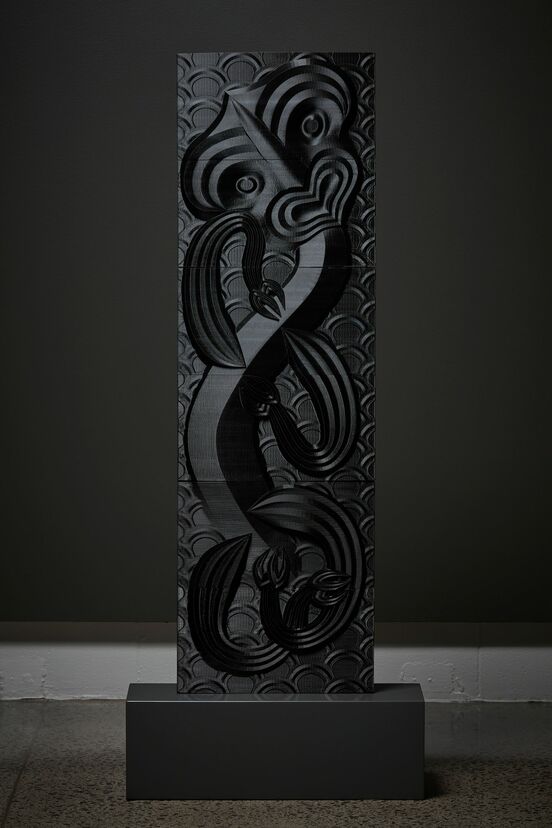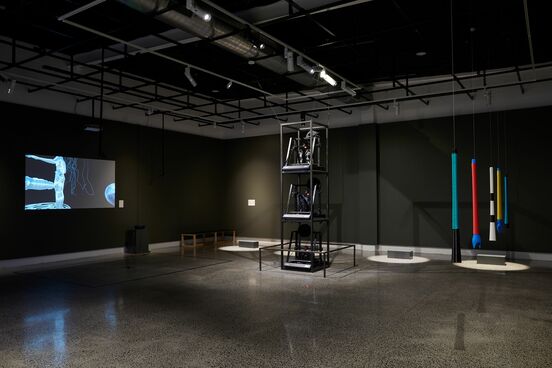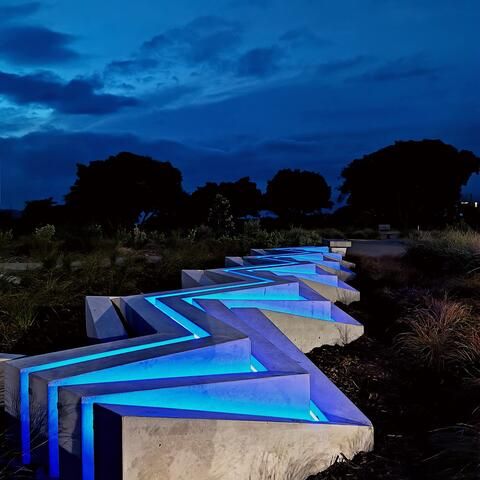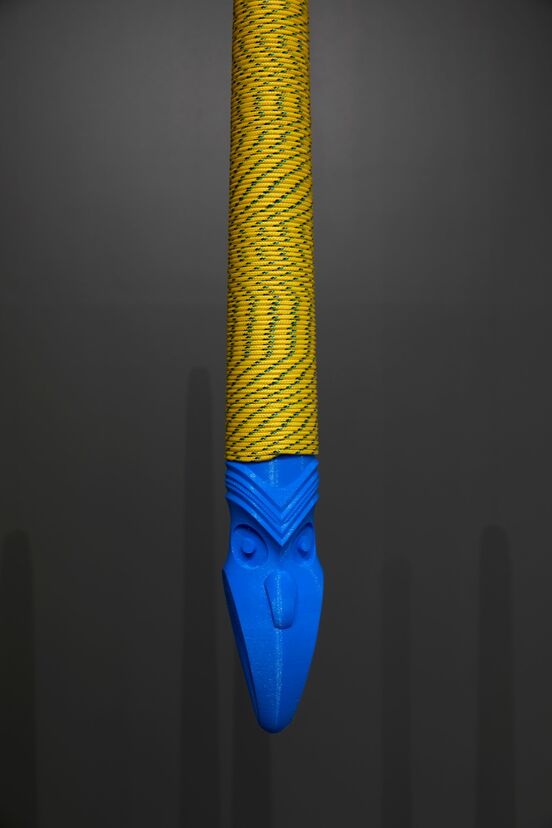-
Author
Zoe Black -
Date
31 Mar 2021
Essay
A Continuous Pathway
In sculptures, 3D-printed 'carvings', installations and virtual works, Kereama Taepa articulates Māori ideas with digital tools. Taepa's incessently innovative work challenges the limits of material and connective strategies, says Zoe Black.
Recently, I have been watching Māori TV's superb documentary series 'Artefact'. Each episode looks at key objects from the history of Aotearoa, alongside stories from knowledge holders contemplating an item's importance in the present day. The series reaffirms that innovation and adaptation have always been at the heart of Māori life. Dame Anne Salmond presents taonga that show Māori were constantly problem solving and that their making practices were continually responding to what was available in the immediate environment – from utilising unfamiliar plants, weaving weather-appropriate clothing or being eager adopters when metal carving tools arrived. She says it was the life of a people "always shifting, always growing – spiralling back to the ancestors, opening up the future".
The work of Kereama Taepa sits easily within a framework of reflective, incessant innovation. Over his career, Taepa has grounded his work within customary Māori knowledge, while incorporating new techniques, materials and processes in the spirit of constant change. Since 2011 he has been experimenting with 3D printing and virtual reality – most notably producing the coveted 3D-printed heitiki which he first made in 2012. He explains that connections can be made between digital spaces and Māori philosophy: "things are there yet not there – both are tangible but yet intangible. I use new technology to connect the now with the past, to present the beginning."
Son of a Māori father and Pākehā mother, Taepa draws on multiple heritages and interests in his creative life – references to retro gaming, science fiction and film, for instance, are considered alongside the carving traditions of Te Āti Awa and Te Arawa from whom he descends. These multi-layered aspects of Taepa's practice mean that Taepa produces both contemporary Māori art and commentary on contemporary art – always through the lens of an artist who relishes in pushing boundaries and seeing just what he can create with the tools available to him.
In 2016 Taepa presented 'a (very) brief history of Aotearoa' as the fifth commission of the 4 Plinths project in Te Papa's forecourt. Taepa topped the plinths with four recognisable shapes, rendered in the visual language of pixelated Space Invaders game icons. Together the symbols – a Māori meeting house, a bishop's mitre, a crown and the Beehive – formed a (very) brief history of our country while drawing links between invasion, colonisation and the spaces in which power exists today. Through familiar arcade visuals and in the potent location in front of Te Papa, the work wittingly spoke of shifting authority, rights denied and access taken away.
Taepa's exploration of contemporary visual culture from a bicultural perspective was developed further in his 2017 exhibition 'Whakapī', curated by Bridget Reweti at Pātaka Art + Museum. In 'Whakapī', Taepa installed a series of sculptural works responding to both the pervasiveness of popular culture and the importance of mātauranga Māori within his practice. On one side of the gallery symbols of modern life were mounted on the wall; on the other, a line of wheku was placed in opposition. While resembling intricately carved artefacts, the sculptures were in fact constructed using 3D printing technology. This process was alluded to in the title of the exhibition – Taepa's new term 'whakapī' plays off the word 'whakairo', meaning carving, in replacing a reference to maggots (iro) with one to bees (pī). While maggots carve out organic material, bees build up their hive in systematic hexagonal shapes, similar to the way a 3D printer works.
A further synthesis of technology and Māori ideas was evident in the way Taepa rendered the surface of the works. Space Invader and Pac-Man imagery adorned the contours of the wheku, while the modern symbols were decorated with traditional whakairo patterns. The combinations gave space for commentary – for example, the jagged whale-tooth pattern taratara ā kae, which indicates abundance, was used to embellish the logo of one of the world's most wealthy brands, Apple.
In the gallery space between the sculptures, a VR experience gave visitors the chance to step through a virtually carved waharoa to see an alternative digital world. Curator Bridget Reweti explains, "As a student of Professor Robert Jahnke, Kereama learnt that the carved figures within the iconic style of Te Āti Awa perform acts which are physically impossible but spiritually possible. Their figurative forms are not bound by our human laws of physics such as gravity or matter." Creating in a digital space allowed Taepa to explore realisations not available within the physical constructs of the gallery and to connect to an alternate spiritual sphere.
Taepa has been pushing elements of 'Whakapī' and 'a (very) brief history' further since 2017, and this year they came together in 'Transmission', at Objectspace. Curated by Ane Tonga, the exhibition took the sonic traditions of te ao Māori as the starting point for an exploration of the way knowledge is passed on through sound. Taepa explains, "It's amazing to me that Māori can communicate their beliefs, through the generations, all with sound. We do have a visual language, but it's a starting point for all the kōrero that comes out."
Five pūkāea (trumpet-like taonga pūoro), 3D-printed in bright primary colours, were suspended at the entrance of the gallery space and created a symbolic opening, an invitation to cross the cultural and spiritual threshold. Pūkāea were traditionally used for signalling in times of conflict and in ceremonial rituals during peacetime. Rather than being a decorative representation, Taepa's instruments are functional, able to be played by masters of taonga pūoro. In this way they bear out Taepa's multiple intentions for 'Transmission', in which the series of works oscillates between honouring atua and tūpuna, exploring materiality and considering the way physical and digital realms can connect and extend one another.
Nearby in the gallery, a stack of 3D printers took centre stage. The stack referenced Tāne both in vertical form and in the poupou they busily printed over the duration of the exhibition, transforming the space into a studio of sorts. Working simultaneously, they built portions of four poupou in the tuare style of Te Āti Awa carving, which, once finished, were assembled to reveal different personifications of Tāne. The continuous printing meant Taepa's process was actively present in the gallery, deepening the audience's understanding of the technology and how it was employed. Rather than presenting them as a replacement for carving, Taepa used the 3D-printed poupou to speak of what could be done with the machines, a whakapī way of working that could exist in parallel to the whakairo of wood and chisel.
Taepa chose to use a 'green' PLA filament derived from corn starch as the base material for his poupou – creating new work from petroleum-based plastic would have been in conflict with the kaupapa of the exhibition. Being plant based, the whakapapa of the material also acknowledged Tāne and customary carving, while suggesting a possible alternative to using native timbers.
'Transmission's' final work, 'Te Oro', combined virtual reality and audio activation, connecting taonga pūoro with the digital space. Taepa identified Te Uira, the god of lightning, as a potential node in a whakapapa that contextualises digital spaces and practices within a Māori cultural paradigm. "Te Uira is the closest parallel of a visual and physical representation of electricity," he says. In the VR experience, Te Uira was rendered in stylised human form and stood in front of a kōauau (an open-ended cross-blown flute) that could be activated by viewers with a VR hand controller. The notes of the kōauau were recorded by Taepa playing one of his own 3D-printed kōauau, creating a cyclical manifestation of digital and physical making. After a short window of audience participation, the work was scaled down after lockdown, due to Covid-19 exigencies. The full version of the work was included as part of 'Toi Tū Toi Ora: Contemporary Māori Art' at Auckland Art Gallery Toi o Tāmaki.
Taepa's interest in creating artworks that physically, aurally and visually engage audiences continues with his latest work, a public sculpture designed for Te Uruhi Maclean Park in Paraparaumu. 'Tohorā' is a 10-metre long, cast-concrete sculpture that uses the traditional Aramoana ocean waves pattern to represent the journey of whales through Te Rau o te Rangi waters. The sculpture lies flat along the landscape and is intended to be interacted with by visitors. "It's a literal pathway," Taepa explains. "The idea is that you can walk on top of it and as you do there's a sensor in the middle which triggers audio, allowing you to hear the sounds of whales and dolphins." As with Taepa's other interactiveworks, 'Tohorā' implores audiences to get amongst the artwork, engage all their senses and experience it in every way possible.
Dame Anne ended one episode of 'Artefact' by saying "there is no static point for Māori, no classic culture". Taepa's practice is a case in point. While the artist honours the cultural knowledge that enables him to create with understanding, he uses everything available to make it relevant for his life today in the 21st century. With his work he urges Māori artists to become space invaders – to occupy those places that may seem foreign or unfamiliar and see where innovation could take them next.
This story first appeared in the Summer 2020 issue of Art News New Zealand.

Kereama Taepa,Tāne-auaha, 2020, 3D-printed poupou, installed in Transmission, Objectspace. Photographer: Samuel Hartnett

Kereama Taepa, Transmission, 2020, installation view at Objectspace, Auckland. Photographer: Samuel Hartnett

Kereama Taepa, Tohorā, 2020, as installed at Te Uruhi Maclean Park, Paraparaumu. Photographer: Karl Webber, courtesy of the artist.

Kereama Taepa, Kia Mataara, 2020, 3D-printed pūkāea, as installed in Transmission, Objectspace. Photographer: Sam Hartnett